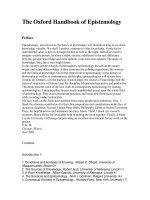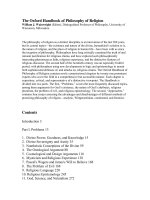- Trang chủ >>
- Khoa Học Tự Nhiên >>
- Vật lý
the oxford handbook of participation in organizations apr 2010
Bạn đang xem bản rút gọn của tài liệu. Xem và tải ngay bản đầy đủ của tài liệu tại đây (2.79 MB, 641 trang )
the oxford handbook of
PARTICIPATION IN
ORGANIZATIONS
This page intentionally left blank
the oxford handbook of
PARTICIPATION
IN ORGANIZATIONS
Edited by
ADRIAN WILKINSON
PAUL J. GOLLAN
MICK MARCHINGTON
and
DAVID LEWIN
1
3
Great Clarendon Street, Oxford ox2 6dp
Oxford University Press is a department of the University of Oxford.
It furthers the University’s objective of excellence in research, scholarship,
and education by publishing worldwide in
Oxford New York
Auckland Cape Town Dar es Salaam Hong Kong Karachi
Kuala Lumpur Madrid Melbourne Mexico City Nairobi
New Delhi Shanghai Taipei Toronto
With offices in
Argentina Austria Brazil Chile Czech Republic France Greece
Guatemala Hungary Italy Japan Poland Portugal Singapore
South Korea Switzerland Thailand Turkey Ukraine Vietnam
Oxford is a registered trade mark of Oxford University Press
in the UK and in certain other countries
Published in the United States
by Oxford University Press Inc., New York
# Oxford University Press 2010
The moral rights of the authors have been asserted
Database right Oxford University Press (maker)
First published 2010
All rights reserved. No part of this publication may be reproduced,
stored in a retrieval system, or transmitted, in any form or by any means,
without the prior permission in writing of Oxford University Press,
or as expressly permitted by law, or under terms agreed with the appropriate
reprographics rights organization. Enquiries concerning reproduction
outside the scope of the above should be sent to the Rights Department,
Oxford University Press, at the address above
You must not circulate this book in any other binding or cover
and you must impose the same condition on any acquirer
British Library Cataloguing in Publication Data
Data available
Library of Congress Cataloging in Publication Data
Data available
Typeset by SPI Publishing Services, Pondicherry, India
Printed in Great Britain
on acid free paper by
CPI Antony Rowe, Chippenham, Wiltshire
ISBN 978 0 19 920726 8
13579108642
Acknowledgements
Thanks to our editor David Musson and Matthew Derbyshire for their patience
and advice along the way.
This page intentionally left blank
Contents
List of Figures x
List of Tables xi
About the Contributors xiii
PART I INTRODUCTION
1. Conceptualizing Employee Participation in Organizations 3
A
DRIAN WILKINSON,PAUL J. GOLLAN,MICK MARCHINGTON,
AND DAVID LEWIN
PART II PERSPECTIVES
2. An HRM Perspective on Employee Participation 29
P
ETER BOXALL AND JOHN PURCELL
3. An Industrial Relations Perspective on Employee Participation 52
P
ETER ACKERS
4. A Legal Perspective on Employee Participation 76
G
LENN PATMORE
5. Labour Process and Marxist Perspectives on Employee Participation 105
M
IGUEL MARTINEZ LUCIO
6. An Economic Perspective on Employee Participation 131
D
AVID MARSDEN AND ALMUDENA CAN
˜
IBANO
PART III FORMS OF PARTICIPATION
IN PRACTICE
7. Direct Employee Participation 167
A
DRIAN WILKINSON AND TONY DUNDON
8. Collective Bargaining as a Form of Employee Participation:
Observations on the United States and Europe 186
R
ICHARD N. BLOCK AND PETER BERG
9. Employer Strategies Towards Non-Union Collective Voice 212
P
AUL J. GOLLAN
10. Worker Directors and Worker Ownership/Cooperatives 237
R
AYMOND MARKEY,GREG PATMORE, AND NIKKI BALNAVE
11. Employee Participation Through Non-Union Forms of Employee
Representation 258
B
RUCE E. KAUFMAN AND DAPHNE G. TARAS
12. Works Councils: The European Model of Industrial Democracy? 286
R
EBECCA GUMBRELL-MCCORMICK AND RICHARD HYMAN
13. Employee Share Ownership 315
E
RIC KAARSEMAKER,ANDREW PENDLETON, AND ERIK POUTSMA
14. Financial Participation 338
I
AN KESSLER
PART IV PROCESSES AND OUTCOMES
15. Labour Union Responses to Participation in Employing Organizations 361
G
REGOR GALL
16. Voice in the Wilderness? The Shift from Union to Non-Union
Voice in Britain 383
R
AFAEL GOMEZ,ALEX BRYSON, AND PAUL WILLMAN
viii contents
17. High Involvement Management and Performance 407
S
TEPHEN WOOD
18. Employee Voice and Mutual Gains 427
D
AVID LEWIN
PART V POLICY AND COMPARATIVE ISSUES
19. Participation Across Organizational Boundaries 455
M
ICK MARCHINGTON AND ANDREW R. TIMMING
20. Public Policy and Employee Participation 476
J
OHN W. BUDD AND STEFAN ZAGELMEYER
21. Corporate Governance and Employee Participation 504
H
OWARD GOSPEL AND ANDREW PENDLETON
22. Cross-National Variation in Representation Rights
and Governance at Work 526
C
AROLA FREGE AND JOHN GODARD
23. Employee Participation in Developing and Emerging Countries 552
G
EOFFREY WOOD
24. International and Comparative Perspectives on Employee Participation 570
N
ICK WAILES AND RUSSELL D. LANSBURY
25. Freedom, Democracy, and Capitalism: Ethics and Employee
Participation 590
R
OBIN ARCHER
Index 609
contents ix
List of Figures
1.1 The escalator of participation 11
2.1 The goals of HRM 41
6.1 Freeman and Lazear’s analysis of voice and power effects in
participation 141
7.1 A strategic choice: a simplified specification 172
7.2 Escalator of employee participation 174
8.1 Percentage of employees who are union members, ten European
countries and United States, 2007 204
8.2 Percentage of employees who are union members, selected OECD
countries, 1980–2007 205
8.3 Percentage change in percent of employees who are union members,
1980–2007, selected OECD countries 206
9.1 Management strategies towards NCV and union responses—a
framework 224
16.1 Trade union density in Britain and the United States (%) 384
16.2 Voice regime choice in Britain for all workplaces 387
16.3 Voice regimes in Britain, 1984–2004 (%) 389
16.4 PLC theory and the rise and fall of union membership 392
16.5 Trends in union membership split by never, current,
and ex-members, 1983–2001 (%) 396
23.1 Forms of voice, participation, and involvement 554
25.1 Freedom and authority 594
List of Tables
2.1 Types of employee voice 33
2.2 Trends in union density across the Anglo-American world 35
6.1 Recent studies of the performance effects of participation 152
7.1 A top-down view of choice 172
8.1 Levels of collective bargaining with regard to wages
selected EU countries 201
8.2 Estimated union density, four teen European Union countries,
Norway, Canada, United States, 2007 203
9.1 Voice regime–effectiveness, risk, direct cost, and switching cost 219
10.1 West European employee representation on company boards 240
10.2 East European employee representation on company boards 242
11.1 Examples of diversity of NER plans 265
11.2 Four faces of NER 271
16.1 Voice regimes in Britain for all workplaces, 1984–2004 388
16.2 Incidence of voice regimes in Britain in 1984 for all workplaces
by set-up date 390
16.3 Voice regimes and mean HRM scores in Britain for all workplaces, 1998 397
18.1 ADR system presence and type in non-union business units 431
18.2 Reasons for ADR system adoption by non-union businesses 432
18.3 Annual average ADR system usage rates in non-union business units,
2002–2006 433
18.4 Issues about which employees exercise voice in non-union
ADR systems 434
18.5 Employee use of non-union ADR systems by demographic
characteristics 436
18.6 Selected characteristics of four non-union business units, ADR
systems, executive interview, and employee sur vey samples 438
18.7 Summary of top executive ratings of ADR system benefits and costs 439
18.8 Summary of non-union employee ratings of ADR system benefits
and costs 441
20.1 Models of the employment relationship and government regulation 478
20.2 Employee participation in organizations 482
20.3 Public policies on employee par ticipation: rationales and examples 487
xii list of tables
About the Contributors
The Editors
Professor Adrian Wilkinson
Adrian Wilkinson is Professor of Employment Relations at Griffith University and
Director of the Centre for Work, Organization, and Wellbeing. He is also a Visiting
Professor at Loughborough University Business School. His books include Making
Quality Critical (1995), Managing Quality and Human Resource (1997), Managing
through TQM: Theory and Practice (1998), Understanding Work and Employment:
Industrial Relations in Transition (2003), Human Resource Management at Work
(2008), Contemporary Human Resource Management (2009), and the Sage Hand-
book of Human Resource Management (2009). He has written over 100 articles in
refereed journals and many book chapters. He is a Fellow and Accredited Examiner
of the Chartered Institute of Personnel and Development. He is chief editor of the
International Journal of Management Reviews and associate editor of the Human
Resource Management Journal.
Associate Professor Paul J. Gollan
Paul J. Gollan is currently an Associate Professor at the Department of Business,
Division of Economic and Financial Studies, Macquarie University. He is also
Associate Fellow in the Employment Relations and Organizational Behaviour
Group in the Department of Management, and Research Associate at the London
School of Economics. He is also a Fellow of the Labour-Management Studies
Foundation at Macquarie University which is jointly hosted by the Division of
Economic and Financial Studies and the Macquarie Graduate School of Manage-
ment (MGSM).
Paul has authored, co-authored, and co-edited a number of books in the fields of
human resources and industrial relations including Employee Relations in the Press
(1997) and Models of Employee Participation in a Changing Global Environment—
Diversity and Interaction (2001). His latest book Employee Representation in Non-
Union Firms was published in 2007. Another book, Strategic Human Resource
Management: A Critical Review is due for release in 2009. He is a co-editor of
Advances in Industr ial and Labor Relations and consulting editor for the Inter-
national Journal of Management Reviews.
Professor Mick Marchington
Mick Marchington has been Professor of Human Resource Management at what is
now Manchester Business School, University of Manchester since 1995, having
joined the University in the late 1980s. Prior to that, he worked at the Universities
of Aston and Central Lancashire. He moved into HRM after gaining a first class
honours degree in Chemical Engineering and indeed much of his work has been in
that sector. While being at Manchester he has also been a Visiting Professor at the
Universities of Sydney, Auckland, and Paris. During his employment at Manches-
ter, he has occupied a wide range of managerial roles, including Dean of Manage-
ment Studies and Divisional Research Co-ordinator. He is currently the fortieth
Anniversary Visiting Fellow at the Institute for Employment Studies.
He has published widely on HRM, including twenty books and monographs,
and nearly 150 book chapters and papers in refereed journals. He is also editor of
the Human Resource Management Journal, one of the leading journals in the area,
and he has been joint chair of the HRM Study Group of the International
Industrial Relations Association since 2003. He has been active in the CIPD since
the late 1980s, as Chief Examiner until 2002 and as Chief Moderator, Standards up
to 2008. He is a Chartered Companion of the CIPD, the highest grade of member-
ship available.
Professor David Lewin
David Lewin is the author of many published works on such topics as human
resource strategy, human resource management practices and business perform-
ance, workplace and organizational dispute resolution, and compensation and
reward systems, including executive compensation and public sector pay practices.
Professor Lewin’s recent books include Human Resource Management: An Eco-
nomic Approach, The Human Resource Management Handbook,andAdvances in
Industrial and Labor Relations. He is presently working on two new books, Conflict
Management in the Modern Corporation and The Dual Theory of Human Resources and
Business Performance. Professor Lewin serves on the editorial boards of Industrial and
Labor Relations Review, Industrial Relations,andCalifornia Management Review,isa
Fellow of the National Academy of Human Resources, a member of the board of
directors of K-Swiss, and a Director of the Law and Economics Consulting Group
(LECG). Professor Lewin has consulted widely with business, government, and
voluntary organizations in the United States and abroad, and serves as an employ-
ment litigation expert. He is also Faculty Director of the UCLA Anderson School’s
Advanced Program in Human Resource Management, Young Presidents’ Organiza-
tion (YPO) Management Seminar, and Strategic Leadership Institute (SLI).
xiv about the contributors
The Contributors
Peter Ackers Professor of Industrial Relations and Labour History, Loug hborough
University.
Robin Archer Lecturer in Political Sociology, The University of London.
Nicola Balnave Senior Lecturer, University of Western Sydney.
Peter Berg Associate Professor of Labour and Industrial Relations, Michigan State
University.
Richard N. Block Professor of Labour and Industrial Relations, Michigan State
University.
Peter Boxall Professor of Human Resource Management, The University of
Auckland.
Alex Bryson Research Director, London School of Economics.
John W. Budd Professor, Department of Human Resources and Industrial Rela-
tions, University of Minnesota.
Almudena Can
˜
ibano Ph.D. student, LSE.
Tony Dundon Lecturer in Human Resource Management, National University of
Ireland, Galway.
Carola Frege Reader in Employment Relations, London School of Economics.
Gregor Gall Professor of Industrial Relations, University of Hetfordshire.
John Godard Professor of Management, University of Manitoba.
Paul J. Gollan Associate Professor, Macquarie University, Sydney.
Rafael Gomez Lecturer in Marketing, The London School of Economics and
Political Science.
Howard Gospel Professor of Management, Kings College, London.
Rebecca Gumbrell-McCormick Lecturer in Management, University of London.
Richard Hyman Professor of Industrial Relations, The London School of
Economics and Political Science.
Eric Kaarsemaker Lecturer in Human Resource Management, University of York.
Bruce E. Kaufman Professor of Economics, Georgia State University.
Ian Kessler University Reader in Employment Relations, University of Oxford.
about the contributors xv
Russell D. Lansbury Professor of Work and Organisational Studies, The Univer-
sity of Sydney.
David Lewin Professor of Management, Human Resources, and Organizational
Behaviour, University of California.
Miguel Mar tinez Lucio Professor of International Human Resource Management,
University of Manchester.
Mick Marchington Professor of Human Resource Management, The University of
Manchester.
Raymond Markey Professor of Employment Relations, Auckland University of
Technology.
David Marsden Chair in Industrial Relations, The London School of Economics
and Political Science.
Glenn Patmore Senior Lecturer, The University of Melbourne.
Andrew Pendleton Professor of Human Resource Management, University of
York.
Erik Poutsma Associate Professor of Employee Relations, Radboud University
Nijmegen.
John Purcell Research Professor—Industrial Relations, The University of
Warwick.
Daphne G. Taras Professor of Industrial Relations, University of Calgary.
Andrew R. Timming Lecturer in International and Comparative HRM, The
University of Manchester.
Nick Wailes Associate Professor, The University of Sydney.
Adrian Wilkinson Director of the Centre for Work, Organization, and Wellbeing,
Griffith University, Brisbane.
Paul Willman Professor of Management, The London School of Economics and
Political Science.
Geoffrey Wood Professor of Human Resource Management, University of
Sheffield.
Stephen Wood Professor of Employment Relations, University of Sheffield.
Stefan Zagelmeyer Professor of Human Resource Management, International
University of Applied Sciences Bad Honnef-Bonn, Germany.
xvi about the contributors
part i
INTRODUCTION
This page intentionally left blank
chapter 1
CONCEPTUALIZING
EMPLOYEE
PARTICIPATION IN
ORGANIZATIONS
adrian wilkinson
paul j. gollan
mick marchington
david lewin
Introduction
The concept of employee participation is common to many diVerent discipline
areas in the social sciences. In terms of the classic texts on the topic, there are books
which relate participation to politics and question the real form of that involve-
ment (Pateman, 1970), that examine the relationship between participation and
satisfaction (Blumberg, 1968), and that link participation to notions of industrial
citizenship (Clegg, 1960; Webb and Webb, 1902). The pioneering work of the
Tavistock Institute (Heller et al., 1998) or the Swedish experiments in work design
(Berggren, 1993) constitute yet more perspectives on the subject. Despite often
using the same terminology, it is also clear that the meaning and form that
participation can take varies considerably depending on the discipline. On the one
hand, it could relate to trade union representation through joint consultative
committees and collective bargaining, to worker cooperatives or to legislation
designed to provide channels for employee representatives to engage in some
form of joint decision making with employers. On the other hand, and at a
diVerent level, it could encompass myriad mechanisms that employers introduce
in order to provide information to their staV or to oVer them the chance to engage
in joint problem-solving groups or use their skills/discretion at work via job
enrichment programmes.
One of the problems in trying to develop any analysis of participation is that
there is potentially limited overlap between these diVerent disciplinary traditions,
and scholars from diverse traditions may know relatively little of the research that
has been done elsewhere. Accordingly in Part 2 of the book, a number of the more
signiWcant disciplinary areas are analysed in greater depth in order to ensure that
readers gain a better appreciation of what par ticipation means from these quite
diVerent contextual perspectives. To some extent this is reXected in the diVerent
terms used to describe the subject. For example, while the notion of industrial
democracy clearly draws on the traditions of political science, and representative
participation and collective bargaining emerge from the industrial relations and
law literatures, employee involvement and engagement are more likely to have their
roots in human resource management where the focus tends to be on the role of
workers as individuals and their relationships with line managers (Wilkinson and
Fay, 2009). While some of the disciplines are more interested in processes, eco-
nomics tends to look more closely at outcomes and the distribution of resources
that Xow from participation.
Not only is there a range of diVerent traditions contributing to the research and
literature on the subject, there is also an extremely diverse set of practices that
congregate under the banner of participation. Part 3 of the book examines the
range of forms that participation can take in practice, and the way in which it meets
objectives that are set for it, either by employers, trade unions, individual workers,
or indeed the state. This requires us to understand the meaning of the terms used in
the literature in order to classify these diverse forms, so as to make sure readers are
not confusing one form with another.
Following Marchington and Wilkinson (2005), participation can be diVeren-
tiated into: direct communication; upward problem solving; representative par-
ticipation; and Wnancial participation. The Wrst two of these are essentially direct
and individually focused, often operating through face-to-face interactions
between supervisors/Wrst line managers and their staV. Some take the form of
verbal participation, while others are based on written information or suggestions.
The third form is quite diVerent and revolves around the role that employee or trade
union representatives play in discussions between managers and the workforce, via
mechanisms, such as joint consultation, worker directors, or even collective
4 conceptualizing employee participation
bargaining. These particular schemes raise major issues about the distribution of
power and inXuence within organizations, and in some cases—unlike direct
participation for the most part—is part of the legislative framework of the country
in which the employ ing organization is located. The Wnal form we consider in the
second part of the book is Wnancial participation, whereby employees have a
monetary stake or beneWt from their work, via proWt sharing or employee share
ownership. In one sense this is a little diVerent from participation based on
information, consultation, and joint decision making because employees might
be encouraged to participate precisely because there is the expectation that their
work eVorts might ultimately be rewarded by additional beneWts. Of course these
forms of participation also raise questions about how the Wnancial beneWts are
allocated, who makes decisions about their distribution, and what happens if the
organization suVers a loss rather than making a proWt.
Although this is sometimes overlooked in studies, par ticipation practices do not
take place in a vacuum without some clearly deWned purpose. As the HR manager of
a Wrm well known for its innovative approach to employee engagement once told
one of the authors, ‘We are here to manufacture high quality products at a proWt not
to practise participation.’ Consequently Part 4 of the book moves on to examine
some of the processes and outcomes associated with participation. A key question is
who gains what from being involved. In most developed countries management are
the key drivers of par ticipation so it is likely they will expect to see some advantage
from investing in what critics might see as an expensive waste of time. Evidence
suggests that senior managers are not likely to persevere with participation if it does
not meet their goals, either in the short or the long term, and that the beneWts must
be seen to outweigh the costs for it to survive. Yet, as versions of high commitment
HRM have some form of participation as a centre-piece of their models, it seems to
be accepted that rather than being seen as a zero sum concept where one party’s
gains come at the expense of the other, participation might lead to a larger cake to be
shared among workers and employers. On the other hand, some critics of partici-
pation would argue that it is only a Wg leaf behind which the worse excesses of
capitalism can hide. Under this scenario, the real purpose of participation schemes,
especially those aimed at individual workers, is to increase work intensiWcation and
con employees into accepting management ideas that may not necessarily be in their
best interests. This might be supplemented by a drive to engage in non-union forms
of participation as well.
Depending on the societal regime within which participation takes place, the
beneWts might be seen in diVerent ways. So, for example, in a liberal market economy
participation is likely to be measured in terms of proWt and shareholder value at the
organizational level and in customer service, product quality, and staV retention at the
workplace level. Issues to do with worker commitment, job satisfaction, and align-
ment with organizational goals are often the proxies used to measure the success of
participation but in themselves these may tell us little about the impact of particular
conceptualizing employee participation 5
schemes on bottom-line success. In coordinated market economies, the focus is
more likely to be longer term and more widely deWned in terms of a range of
stakeholder interests: government; employers; trade unions; and workers. The time-
scale over which returns are expected is also longer, and the focus—for the most
part—is on peak level institutions and forms of participation that are representative
in nature. In other words, in these situations the expectation is more likely to be of
mutual gains, either at the level of the individual employing organization or more
broadly in terms of citizenship and long-term social cohesion.
This theme is also woven through the Wnal parts of the book. In Part 5, contribu-
tors focus on issues beyond the individual workplace, and on the role that employee
participation plays in societies more generally. We know from the studies that have
been published over time that participation can take diverse forms in diVerent
countries given the role of the state and institutional frameworks in shaping the
environment in which it operates. If legislation is extensive, then participation will be
present—at least in structural terms—in all organizations above a certain size within
that country. It could be argued that this, therefore, provides a safety net and a
structure around which other forms of participation can develop, and in most cases
that has been assumed to happen. However, there is also the possibility that the
presence of formal structures could also hamper the growth, sustainability, and
contribution of more informal participation practices, and it is also likely that at
least some employers might try to Wnd ways around the requirement to involve their
employees. For example, given the growth in subcontracting, employers might seek
to avoid some of their responsibilities by shifting work to other organizations, either
in the same country or even overseas where the same level of regulations do not exist.
This raises major questions about ethics, public policy, and corporate governance,
issues that are explored in chapters later in the book.
Discussion about comparative and societal issues provides a valuable lens
through which to examine the extent to which product and labour markets can
determine the forms that participation takes in practice. In Anglo-Saxon econ-
omies, where the amount of legislation governing participation is limited and
employers have a fair degree of choice in what practices to implement, it is easy
to assume that markets are very important. The Wnancial turmoil that commenced
in 2008–2009 shows how inXuential they can be. However, in countries where
legislation is more extensive and there is a stronger state commitment to long-term
Wnancial stability, the power of product markets is likely to be constrained and
there is a greater chance that higher-level forms of participation will survive.
Similarly, in developing countries, labour market expectations may shape partici-
pation depending on educational and training opportunities for the population as
a whole or on the way in which cultural traditions promote acceptance of or
challenge to management decisions.
Having introduced the broad ideas behind the book and its overall shape, we can
now turn to examine the forces that shape participation and the ways in which it
6 conceptualizing employee participation
can be deWned. In the next section we examine the dynamics of participation in
practice, illustrating how diVerent forms have come to prominence at diVerent
periods in recent history. We also look at how these speciWc practices might interact
with one another. Following this we review the ways in which participation can be
deWned. We believe Wrmly that the concept of par ticipation needs to be broken
down into its constituent parts so as to allow a sharper analytical edge when
investigating the range of forms that it can take in practice and comparing diVerent
perspectives on the topic. In the Wnal section of this chapter, we introduce brieXy
the rest of the book.
The Dynamics of Employee
Participation in Context
Although much of the research has focused on particular forms of participation, it
is also important to note how these forms vary over time, and how they interact
with each other. It is clear that new forms of employee participation have emerged
during diVerent periods, sometimes replacing and at other times coexisting with
prior forms of participation. The political and economic environment has been a
key inXuence on the emergence and spread of particular forms of employee
participation, especially in developed economies. During the 1970s, for example,
the idea of power sharing through broad industrial democracy and narrower
representative participation through trade unions took hold. The subsequent
decline in union membership and changes in public policy during the 1980s and
1990s combined to move industrial democracy oV the domestic agenda of most
advanced economies. In its place came a more managerially-oriented set of prac-
tices under the banner of employee involvement (EI), where the focus was at
workplace level and the outcomes were more explicitly measured in terms of
what employers might gain from these arrangements (Marchington et al., 1992).
During the late 1990s and early part of this century, however, the potential impact
of the Information and Consultation Directive on industrial democracy in the
United Kingdom led to renewed debate about employee participation in organ-
izations (Gollan and Wilkinson, 2007; Gospel and Willman, 2003).
This British example is by no means an isolated one because the last twenty years
have witnessed growing interest in employee participation, speciWcally in employee
involvement. Recent EI initiatives have been largely management sponsored, there-
fore, and not surprisingly, such initiatives reXect management’s dominant concerns
about employee motivation and commitment to organizational objectives. Given
there has been no legislative framework behind these developments, the take-up of
conceptualizing employee participation 7
EI is voluntary and heavily reliant on senior management at each workplace and the
expectations of workers and managers at local level. Although evidence shows that
direct EI has become much more important across Europe (Kessler et al., 2004), this
has been because it Wts with the times. Any attempt to legislate would be opposed by
employers, and indeed it is hard to see what its role might be, given that direct
participation and EI rely on Xexible arrangements which suit particular workplaces
and competitive pressures. These EI initiatives have focused on direct participation
by small groups of employees in workplace level information sharing and decision
making rather than on employee input into higher-level decision making. For
whatever else can be said about it, such direct employee participation in workplace
level decision making is fundamentally diVerent from earlier notions of industrial
democracy and representative participation (Marchington and Wilkinson, 2005).
A major factor shaping employ ee participation in private sector organizations is
increasing product market competition. The public sector has also been subjected to
increasing competition, as reXected in numerous deregulation and privatization
actions on the part of governments and in the rise of the idea of the citizen–taxpayer
as a ‘ customer’ of the go vernment. In both sectors, increased competition has led to a
barrage of new employee participation initiativ es. Shifts in the structur e of employ-
ment awa y fr om manufacturing towar d servic es have also impacted concepts, forms,
uses, and scope of employee part icipation as well as the employment relationship,
per se. (Wilkinson et al., 2007). In particular , both private and public sector employers
have substantially increased their use of contracted or outsourc ed employees. In
these situations, where the employer is ‘ elusiv e’ and there is no simple, traditional
employer–emplo y ee relationship , it becomes more diYcult to devise a nd implement
appropriate systems of employee participation (Marchington et al., 2005).
While each of the aforementioned factors is important in shaping the environ-
ment within which direct employee participation operates, it is also necessary to
examine how macro-level factors interact with developments at the organizational
level—where business decisions are made—to inXuence employee participation.
Notable here is the inXuence of ‘ideas brokers’—consultants and popular manage-
ment writers—who oVer their particular interpretations of the changing global
marketplace and who advocate normative recipes for responding to such change.
To illustrate, organizations are encouraged to be Xexible, innovative, and respon-
sive in dealing with newly intensiWed global competition, rather than seek eco-
nomies of scale through more conventional mass production (Piore and Sabel, 1983).
A related line of reasoning argues that the knowledge economy provides enhanced
impetus for employee involvement in decision making, which is claimed to be a
positive development for employers and employees (Scarborough, 2003). Assessing
such arguments, Poole et al. (2000: 497) observe that ‘increased competition and
concerns about economic performance have made the achievement of ‘‘rights-
based’’ employee participation more remote whilst encouraging the development
of EI as a route to better ‘‘market performance’’ ’.
8 conceptualizing employee participation









